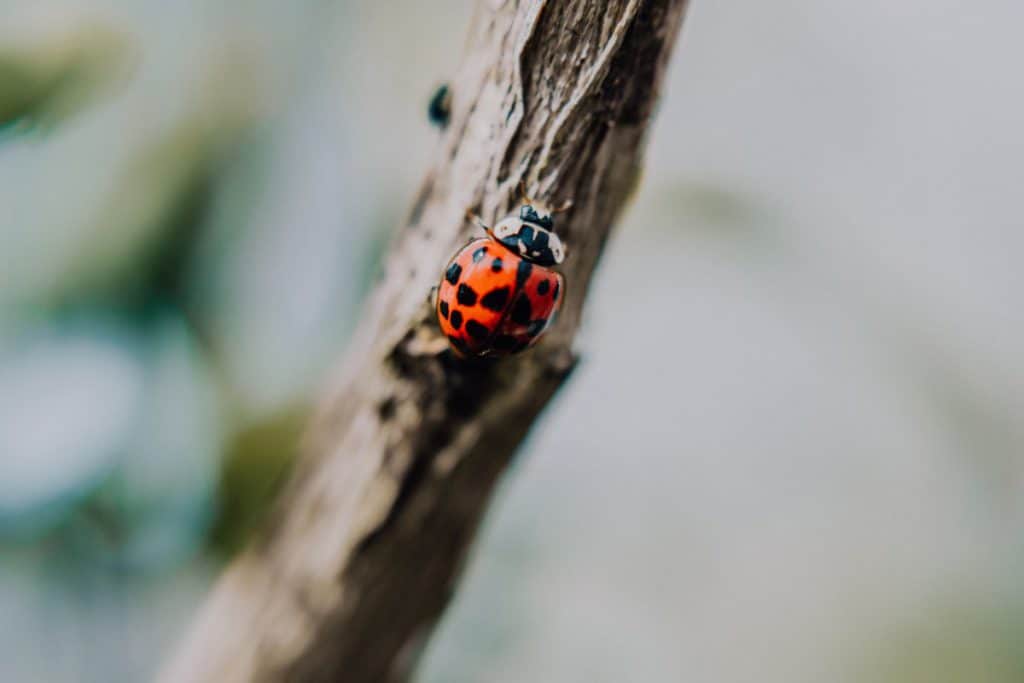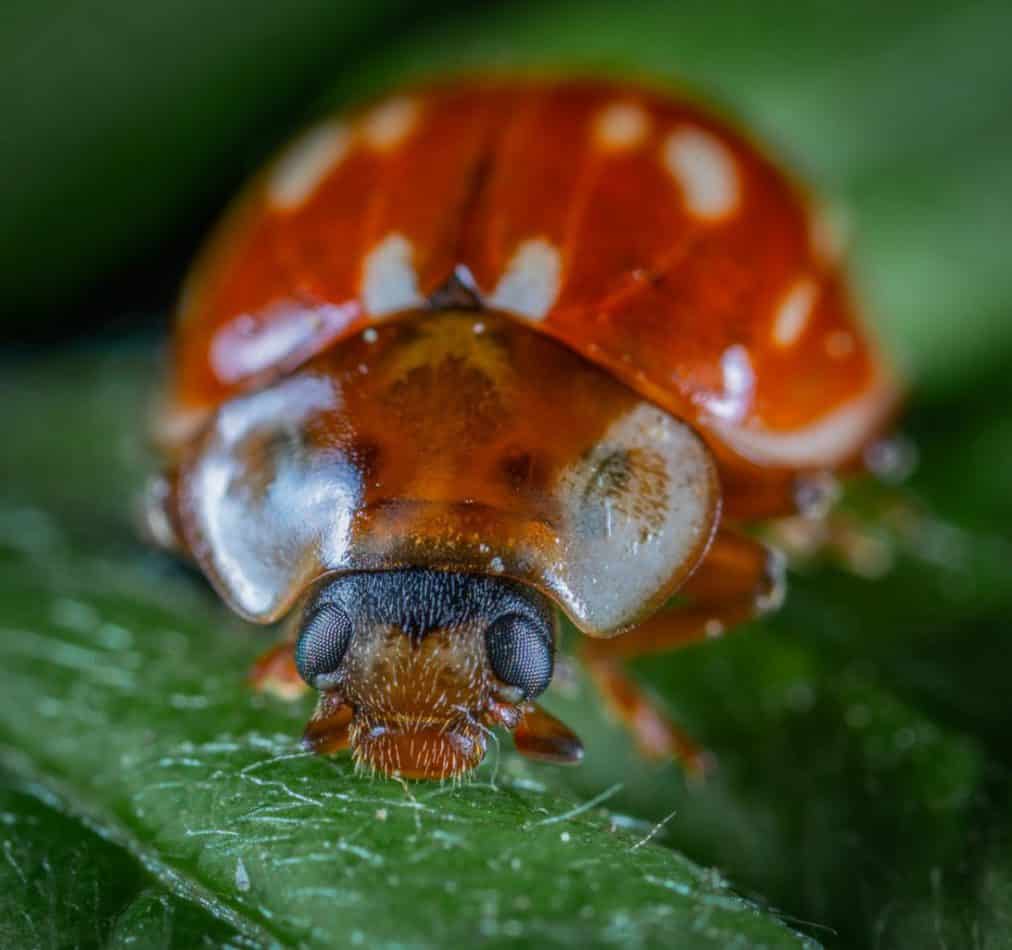
If you enjoy reading this article, why not check out our articles on Are Ladybugs Poisonous and What Can Ladybugs Damage? The surprising answer.
Fascinating Facts About Ladybugs
Ladybugs are fascinating insects and very fun to look at because of their different colors. These little critters are known to be beneficial predators since they love to eat plant pests. Plenty of rumors have been surrounding this creature as to how to determine their age. There has been some talk about ladybugs and their age being associated with their spots. This article will talk about how you can tell the age of a ladybug and what their places are for.
Do Ladybugs Spots Tell Their Age?
The answer is no. The spots on the ladybug’s back are to determine what species they are. It is a common misconception that the spots represent their age.
Knowing the Age of a Ladybug
It has been a long-time myth that the ladybug’s spots tell their age. But the truth is, it is not true. The ladybug’s spot tells the species of ladybugs and not their age. Ladybugs live for just about a year, so it doesn’t make sense that if they have thirteen spots, they are thirteen years old.

What is the life cycle of a ladybug?
It would be impossible to find a ladybug that lives for more than a year. Their life cycle begins when a batch of bright yellow eggs are laid on branches near food sources. From there, it only takes about three to four weeks before they emerge as an adult.
They hatch in about four to ten days and turn into larvae. They spend about three weeks eating and filling up their stomachs. Some larvae may eat eggs that may not have been hatched yet. Once they are well fed, they will begin to build up a pupa and turn into a full adult after ten days.
What do the Ladybugs Spots tell about?
The number of spots can help identify the species of a ladybug because they have a specific amount of spots on their backs. For example, coccinella septempuctata has seven spots on their backs. On the other hand, the ladybug is a vast family species, which is why there are exceptions.
Some ladybugs do not have spots at all, and some have stripes instead of spots. Others differ in the number of spots but still counted as the same species. A good example is the Asian Lady Beetle, which spots can range from 0 to 22.
There’s no way to tell a ladybug’s age. It is only known that they live for about a year. They have such a fast phase lifecycle that they only get to live in such a short period.
Ladybugs are a bit difficult to determine, but they are such beautiful creatures. However, no matter how many their spots are, it is not a way to assess a ladybug’s age.
Ladybug’s Spots and Their Species
Ladybugs are such colorful insects, and their spots are so interesting since you can tell their species by just looking at them. The following are different types of ladybug species and how you can tell them apart by looking at their spots.
Adalia Bipunctata
About: This ladybug is known as the two-spotted ladybird since they have two black spots on their solid red backs. They are part of the big section of the black and red ladybug family. To determine them from other red ladybugs, they have two white spots on their heads.
Where it is Found: The Adalia Bipunctata is found in western and central Europe as well as North America. However, their numbers have massively declined in many states and provinces of North America.
Calvia Quatuordecimguttata
About: These ladybugs are known as the cream spotted ladybird. In Europe, they have fourteen cream spots on their maroon brown back. However, in North America, these species have different colors and spot count.
Where It Is Found: They are black and have white spots, which are similar to the Europe ladybug but darker. They can also range in yellow to pink color. The calvia quatuordecimguttata in North America has eighteen large cream spots on their backs.
Coccinula Redimita
About: Now, these types of ladybugs do not have spots on their backs. They are a mix of light brown and black. The black part of their color is mixed in with their base color, which is light brown.
Where It Is Found? The coccinula redimita is found in most of Europe and some parts of North America. There has been little information about this ladybug because scientists just recently discovered it.
Halyzia Sedecimguttata
About: This ladybug has an oblong-shaped body, rather round than elongated. They have a striking orange color as their base with sixteen, sometimes less, creamy white large spots. Their neck shield usually covers their heads and shows orange-colored spots.
Where It Is Found? The halyzia sedecimguttata is found in Western Europe. They are commonly found in woodlands and more frequently in dry areas as well as parkland, forest edges, and on hedges.
Harmonia axyridis
About: These ladybugs are known as the Harlequin and as the Asian Lady Beetle. They come in an extensive range of color. Their color comes in orange or red, with 0 to 22 black spots depending on their size. Check out our article Are Ladybugs Poisonous if you’re interested in learning more about the Asian Lady Beetle and how it might affect your garden.
Where It Is Found? Others are uniformly black, with two to four red spots on their back. The Harmonia axyridis is found in most parts of Asia and has been introduced to North America and Europe to control pests in gardens and farmlands.
Hippodamia Notata
About: These ladybugs have domed backs, mainly oval, with short legs and antennae. Their pronotum (a plate-like hard exoskeleton that hides the thorax) is mostly black, with white markings on the front edge. Their primary color is yellow-orange to red and has ten black spots on their backs.
Where It Is Found? The hippodamia notata is found in most parts of Europe, East Palearctic ecozone, and in the Near East. They usually live in forest edges and clearings.
Illeis Galbula
About: They are also known as the fungus eating ladybird. They grow from 4-5mm in size as an adult, and the larvae are between 8 and 10mm. They are the fastest species of ladybugs, and if they are disturbed, they fly or drop on their backs.
Where It Is Found? Just like the coccinula redimita, these ladybugs do not have spots on their backs. Adults are bright yellow with black markings on their backs. It looks as if the colors are blending, which is why they do not have spots on their backs.
Mysia Oblongoguttata
About: These types of ladybug species are also known as the striped ladybird. They are found in Palearctic areas. You can find these little guys in mixed forests and birch forests as well as grasslands.
Where It Is Found? As per its name, this ladybug does not have any spots on their back. They are light brown in color and has small white stripes on their backs. They also have two big white spots on the top of their heads near the antennae.
Propylea Quatuordecimpunctata
About: This is also known as the 14-spotted ladybird or the 14-spotted ladybird beetle. There are over a hundred color and pattern variations, which is why, at some point, they were considered to be different species.
Their background color ranges from cream to yellow to light orange but never red. They have 14 black, almost rectangular spots on their backs. Most commonly, the spots fuse into more extensive markings, particularly along the midline on their backs.
For more about all the different colors of ladybugs out there, and why certain ladybugs are different colors, you may want to read our article: The Color of Ladybugs – Explained.
Where It Is Found? They are common species in Europe, North Africa, Cyprus, European Russia, Ukraine, and Korea. It just recently spread in North America, from southeastern Canada to Great Lakes and Florida, and is still spreading.
Psyllobora Vigintiduopunctata
About: They are known as the 22-spot ladybird, and they are commonly found in Europe. Their elytra (fore wings) are yellow with 22 black spots, and their pronotum has five spots as well.
Where It Is Found? These ladybugs are also found in provinces such as Kerman, Mazandaran, and Gilan. They do not feed on aphids as other ladybugs do, but they feed on mildew, especially from low growing shrubs.
Subcoccinella Vigintiquatuorpunctata
About: These species are also known to have the most spots. They are known as the 24-spot ladybird, and they are usually 3 to 4mm long. The ladybug is dark orange, including its antennae as well as the legs.
Where It Is Found? They also have a black spot on their wing cases. This ladybug species is found across Europe, North America, Ukraine, China, North, and South Korea. It was introduced in North America for about a century now.
Conclusion
Ladybugs are known to be an excellent insect to have in your garden. There has been a buzz about determining their age using their spots. However, it is not true. It is known to be one of the garden myths that people know. The spots on a ladybug can tell what their species are. Ladybugs can only live up to a year, which makes it impossible for their spots to determine their age because the most spots that a ladybug has is 24. With all of the species that a ladybug has, it can get difficult determining which is which. Unless you have a microscope on hand and become an expert on ladybugs it is near impossible to determine their age.
If you enjoyed reading this article, why not check out our articles on Can You Keep Ladybugs as Pets and The Color of Ladybugs – Explained.
Recent Posts
Tiny Black Bugs in Bathroom NO WINGS: What They Are and What to Do!
Finding tiny black bugs in your bathroom can be uncomfortable, to say the least. Especially if they are persistent, or they appear in very large numbers, which they often like to do. When it...
Tiny Black Bugs in Plant Soil - What Are They & What To Do About It
A short horror story: You get a new houseplant. You do your best to take care of it. You’ve ensured that it has the right soil, the right amount of sun, it gets enough water. And then one day, you...

